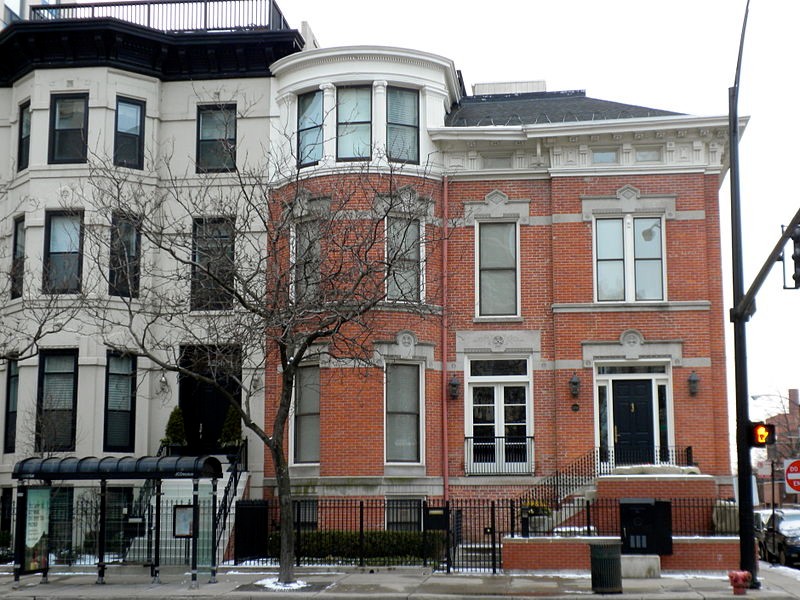Swedish Club of Chicago
Introduction
Text-to-speech Audio
More than one million Swedes permanently emigrated to Chcago between 1845 and 1930, some stayed and others moved on to rural (farming) locations. By 1910, one-fifth of all people who were born in Sweden lived in the United States. Only Ireland and Norway lost a higher proportion of their population in the migration to America. The Swedish Club of Chicago adopted bylaws in 1922 that stated, "The object of this association shall be: to preserve Swedish Language, Customs,
Song, Music, Art, and Industry; to promote Social Intercourse; to maintain a Club
House and Library." (Source: Swedish-American Historical Society Library)
Images
Swedish Club of Chicago Building - Photo credit: https://upload.wikimedia.org/wikipedia/commons/thumb/4/4c/Swedish_Club_of_Chicago.JPG/800px-Swedish_Club_of_Chicago.JPG

Backstory and Context
Text-to-speech Audio
The Swedish Club of Chicago, listed on the National Register for Historic Places, represents a time when European immigration dominated the American-urban landscape during the Industrial Revolution - the Swedes were a big part of that story in Chicago and the Midwest.
More than one million Swedes permanently emigrated to Chicago between 1845 and 1930, pushed by Sweden's overpopulation and late industrialized economy, and pulled to Chicago by the abundance of agricultural land in the Midwest and the Plains, as well as Chicago's ever-growing labor market. By 1910, one-fifth of all people who were born in Sweden lived in the United States; only Ireland and Norway lost a higher proportion of their popuation in the migration to America.1
In 1906 Svenska Glee-Klubben changed its name to Svenska Klubben and applied for incorporation in the State of Illinois in 1923, but the Secretary of State refused to
Today, like many immigrant groups, the enclave may be missing but the spirit lives on through a historical society; The Swedish-American Historical Society. On their site, it notes:
More than one million Swedes permanently emigrated to Chicago between 1845 and 1930, pushed by Sweden's overpopulation and late industrialized economy, and pulled to Chicago by the abundance of agricultural land in the Midwest and the Plains, as well as Chicago's ever-growing labor market. By 1910, one-fifth of all people who were born in Sweden lived in the United States; only Ireland and Norway lost a higher proportion of their popuation in the migration to America.1
The genesis of the Swedish Club of Chicago is tied to Föreningen Freja, an immigrant singing society started in 1869 (incorporated,1874) that provided insurance and sick benefits to its members. Föreningen Freja went dormant from 1881 to 1886, so some of its members, in 1882, merged with a non-singing club known as the Svenska Klubben (The Swedish Club) in 1882. This social club was located at 155 East Chicago Avenue. Föreningen Freja returned in 1887, but by 1889 both clubs consolidated and formed the Svenska Glee-Klubben i Chicago (the Swedish Glee Club in Chicago). And then, in 1896, they moved to the Lasalle location that now exists on the National Register for Historic Places.2
In 1906 Svenska Glee-Klubben changed its name to Svenska Klubben and applied for incorporation in the State of Illinois in 1923, but the Secretary of State refused to
incorporate an organization with a foreign name. Hence, they were renamed "The Swedish Club of Chicago" (incorporated July 13, 1923). At that time, they adopted by laws that stated:
The object of this association shall be: to preserve Swedish Language, Customs, Song, Music, Art, and Industry; to promote Social Intercourse; to maintain a Club House and Library.3Over time, as immigration numbers waned and intermarriage depleted the purely-Swedish population (as is the case with most of the immigrants that arrived prior to, and during, the World War eras), the club transitioned mainly to a social club. And then, by 1884, rising costs and a rapidly declining membership forced its closure.
Today, like many immigrant groups, the enclave may be missing but the spirit lives on through a historical society; The Swedish-American Historical Society. On their site, it notes:
The Swedish–American Historical Society grew out of the national 1948 Swedish Pioneer Centennial celebration marking the 100th anniversary of the arrival of the first Swedish immigrants in the Midwest. In Chicago, 18,000 people filled the stadium on June 4th to hear President Truman, Prince Bertil of Sweden, Carl Sandburg, and representatives from many Swedish–American organizations. Four months later, on October 15, 1948, the leaders of the centennial celebration met in Chicago and formed the Society, originally called the Swedish Pioneer Historical Society.
Our Mission
The Swedish–American Historical Society is a nonprofit organization founded in 1948, with the mission of recording and interpreting the Swedish presence in America. The society is devoted to the mission of studying the Swedish emigration, its history and culture of the Swedes in North America through research, publications, programs and archives.
In 1983, the Board of Directors approved a change in the organization's name to the Swedish–American Historical Society. By then it had moved well beyond a focus on just the "pioneer" period and serves to promote interest in the entire Swedish presence in America, from the first settlers on the Delaware in 1638 to the present day.4
Sources
1 Anita Olson Gustafson, "Swedes," Encyclopedia of Chicago, chicagohistory.org, last updated 2005, http://www.encyclopedia.chicagohistory.org/pages/1222.html
2 Swedish-American Archives of Greater Chicago Manuscript Collection #34 Swedish Club of Chicago Records, 1910-1984 (Chicago: F.M. Johnson Archives and Special Collections
Brandel Library, North Park University, 2012), http://www.northpark.edu/Brandel-Library/Archives/Swedish-American-Archives-of-Greater-Chicago/~/media/Files/PDF/Brandel%20Library/Archives/MSS%20finding%20aids%20SAAGC/SAAGC%20MSS%2034%20Swedish%20Club%20of%20Chicago.ashx
3 Ibid.
4 "Our History, Our Mission," Swedish-American Historical Society, swedishamericanhist.org, last updated 2016, https://www.swedishamericanhist.org/
